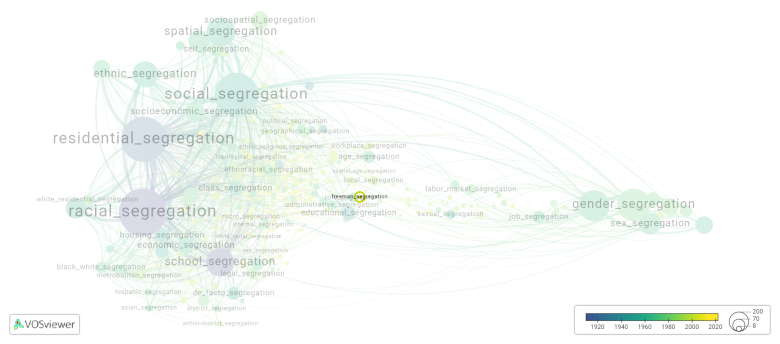Freeman segregation: Difference between revisions
(Creating page) |
(Creating page) |
||
| (4 intermediate revisions by the same user not shown) | |||
| Line 17: | Line 17: | ||
While the explicit legal segregation of the past has been officially abolished, its legacy continues to affect housing patterns and racial disparities in the United States today. Efforts to address these disparities and promote fair housing remain ongoing. | While the explicit legal segregation of the past has been officially abolished, its legacy continues to affect housing patterns and racial disparities in the United States today. Efforts to address these disparities and promote fair housing remain ongoing. | ||
==== | ==See also== | ||
==Related segregation forms== | |||
Freeman segregation is frequently discussed in the literature with the following segregation forms: | |||
[[gender segregation]] | |||
[[File:freeman_segregation.png|780x780px]] | |||
This visualization is based on the study [[Segregation_Wiki:About| The Multidisciplinary Landscape of Segregation Research]]. | |||
For the complete network of interrelated segregation forms, please refer to: | |||
* [https://tinyurl.com/2235lkhw First year of publication] | |||
* [https://tinyurl.com/2d8wg5n3 Louvain clusters] | |||
* [https://tinyurl.com/223udk5r Betweenness centrality] | |||
* [https://tinyurl.com/244d8unz Disciplines in which segregation forms first emerged (Scopus database).] | |||
==References== | ==References== | ||
==Notes== | ==Notes== | ||
<references /> | <references /> | ||
{{NoteAI}} | {{NoteAI}} | ||
==Freeman | ==Freeman segregation appears in the following literature== | ||
Faris R., Ennett S. (2012 | Faris R., Ennett S. (2012). Adolescent aggression: The role of peer group status motives, peer aggression, and group characteristics. ''Social Networks'', ''34''(4), 371-378. https://doi.org/10.1016/j.socnet.2010.06.003 | ||
Goel R., Sharma R., Aasa A. (2021 | Goel R., Sharma R., Aasa A. (2021). Studying segregation in Estonia using call data records. ''Social Network Analysis and Mining'', ''11''(1), -. Springer.https://doi.org/10.1007/s13278-021-00817-0 | ||
Novotný V., Satoh K., Nagel M. (2021 | Novotný V., Satoh K., Nagel M. (2021). Refining the Multiple Streams Framework’s Integration Concept: Renewable Energy Policy and Ecological Modernization in Germany and Japan in Comparative Perspective. ''Journal of Comparative Policy Analysis: Research and Practice'', ''23''(3), 291-309. Routledge.https://doi.org/10.1080/13876988.2020.1770089 | ||
Latest revision as of 07:17, 16 October 2024
Date and country of first publication[1][edit | edit source]
2012
United States
Definition[edit | edit source]
Freeman segregation refers to the practice of segregated housing in the United States, particularly in the years following the Civil War and Reconstruction. The term "freeman" refers to freed slaves or individuals who were formerly enslaved.
After the Emancipation Proclamation and the end of the Civil War, many freed slaves sought to establish new lives and communities. However, due to widespread racism and discrimination, they often faced significant obstacles in securing fair and equal housing.
White landowners and local governments implemented various measures to enforce segregation and maintain racial hierarchy. These included laws known as "Jim Crow" laws, which mandated racial segregation in public facilities, including schools, transportation, and housing.
In response, African Americans established their own communities and neighborhoods, often out of necessity. These communities became centers of Black culture, economic activity, and political organizing. However, they were often marginalized and underfunded compared to predominantly white neighborhoods.
Freeman segregation contributed to the perpetuation of racial inequality and discrimination. It limited economic opportunities, educational access, and social mobility for African Americans. Redlining, a discriminatory practice by which banks and insurance companies denied loans and services to certain areas based on racial composition, exacerbated the negative effects of freeman segregation.
The struggle against Freeman segregation was a significant part of the broader Civil Rights Movement, which sought to dismantle racial segregation and discrimination. The legal landmark case Brown v. Board of Education (1954) played a crucial role in challenging the segregation of public schools and paved the way for further desegregation efforts.
While the explicit legal segregation of the past has been officially abolished, its legacy continues to affect housing patterns and racial disparities in the United States today. Efforts to address these disparities and promote fair housing remain ongoing.
See also[edit | edit source]
Related segregation forms[edit | edit source]
Freeman segregation is frequently discussed in the literature with the following segregation forms:
This visualization is based on the study The Multidisciplinary Landscape of Segregation Research.
For the complete network of interrelated segregation forms, please refer to:
References[edit | edit source]
Notes[edit | edit source]
- ↑ Date and country of first publication as informed by the Scopus database (December 2023).
At its current state, this definition has been generated by a Large Language Model (LLM) so far without review by an independent researcher or a member of the curating team of segregation experts that keep the Segregation Wiki online. While we strive for accuracy, we cannot guarantee its reliability, completeness and timeliness. Please use this content with caution and verify information as needed. Also, feel free to improve on the definition as you see fit, including the use of references and other informational resources. We value your input in enhancing the quality and accuracy of the definitions of segregation forms collectively offered in the Segregation Wiki ©.
Freeman segregation appears in the following literature[edit | edit source]
Faris R., Ennett S. (2012). Adolescent aggression: The role of peer group status motives, peer aggression, and group characteristics. Social Networks, 34(4), 371-378. https://doi.org/10.1016/j.socnet.2010.06.003
Goel R., Sharma R., Aasa A. (2021). Studying segregation in Estonia using call data records. Social Network Analysis and Mining, 11(1), -. Springer.https://doi.org/10.1007/s13278-021-00817-0
Novotný V., Satoh K., Nagel M. (2021). Refining the Multiple Streams Framework’s Integration Concept: Renewable Energy Policy and Ecological Modernization in Germany and Japan in Comparative Perspective. Journal of Comparative Policy Analysis: Research and Practice, 23(3), 291-309. Routledge.https://doi.org/10.1080/13876988.2020.1770089

